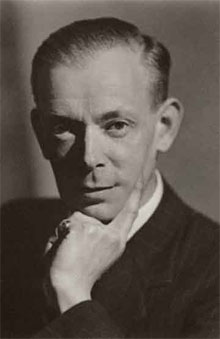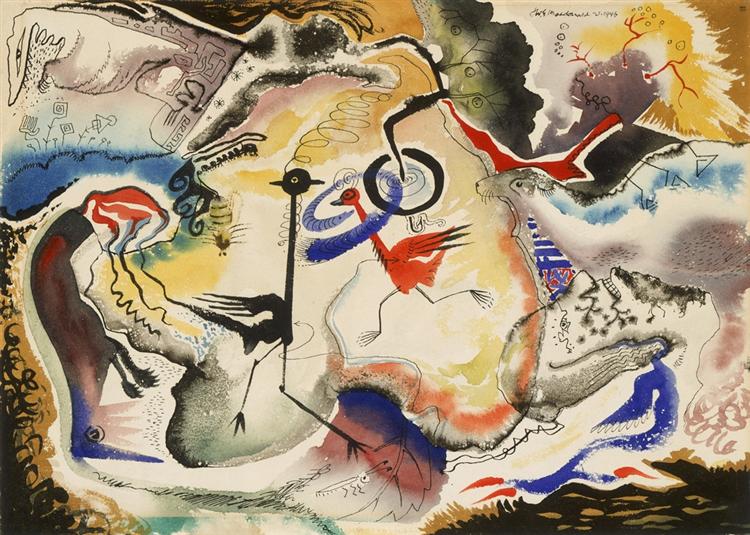
James Williamson Galloway "Jock" Macdonald, born in Thurso, Scotland, in 1897, was a pivotal figure in the evolution of modern Canadian art. His life and work, marked by innovation, perseverance, and an unyielding commitment to artistic exploration, have left an indelible impact on the Canadian art landscape.
Early Life and Education
Jock Macdonald's artistic journey began in his youth. Born into a family with an architectural background, he was surrounded by design and creativity from an early age. His talent was evident early on, winning art prizes at the Miller Institute in Thurso before moving on to George Watson's Boys College in Edinburgh, where he further honed his skills, culminating in the prestigious art prize of the College in 1914.
After a brief interlude in military service during World War I, Macdonald pursued formal art education at the Edinburgh College of Art, specializing in textiles, commercial advertising, and wood-carving. His time there was marked by significant achievements, including the Design Travelling Scholarship and the Art Wood-carving prize, which set the stage for his future endeavors.
Career Beginnings and the Move to Canada
Macdonald's early career was rooted in design, where he worked for Morton Sundour Fabrics Limited, creating textiles and tapestries. However, his passion for teaching and a desire to explore new horizons led him to apply for a position in Canada. In 1926, he moved to Vancouver to join the Vancouver School of Art as Head of Design. It was in this new environment, surrounded by the rugged beauty of British Columbia, that Macdonald's interest in painting truly blossomed.
Encouraged by fellow artist Fred Varley, a member of the Group of Seven, Macdonald began to experiment with oils, marking the start of his transition from design to painting. His early works, heavily influenced by Varley and the Canadian landscape, were deeply rooted in the natural beauty of British Columbia. Over time, Macdonald sought to develop his unique style, moving away from Varley's influence to explore new artistic directions.
The British Columbia College of Arts and Abstract Exploration
In 1933, Macdonald and Varley co-founded the British Columbia College of Arts, a groundbreaking institution that reflected their shared dissatisfaction with traditional art education. The school, though short-lived, was a hotbed of creativity and innovation, attracting students and faculty members who were eager to push the boundaries of art.
It was during this period that Macdonald began to delve into abstract art, influenced by European modernists such as Kandinsky, Paul Klee, and Miro. His first abstract painting, "Formative Colour Activity," created in 1934, marked a significant departure from his earlier work and established him as one of the pioneers of abstraction in Canada.

Nootka Island and the Evolution of Style
The financial difficulties that led to the closure of the British Columbia College of Arts in 1935 prompted Macdonald to seek refuge in nature. He and his family moved to Nootka Island, where they lived in relative isolation for 18 months. This period was transformative for Macdonald, both personally and artistically. The rugged, untamed landscapes of Nootka Island deeply influenced his work, leading to a series of powerful canvases that captured the raw beauty of the West Coast.
The experience also reinforced Macdonald's interest in abstraction, as he began to explore new techniques and forms in his paintings. His work from this period, such as "Graveyard of The Pacific" and "Friendly Cove, Nootka Sound, B.C.," displayed a growing complexity and depth, blending the natural world with abstract forms in a way that was uniquely his own.
Return to Teaching and the Rise of Painters Eleven
After returning to Vancouver, Macdonald resumed teaching, eventually joining the staff of Templeton Junior High School. Despite the constraints of the school curriculum, he continued to pursue his passion for painting, gaining national recognition for his landscapes and abstract studies. His work was exhibited at major events, including the New York World's Fair in 1939, solidifying his reputation as a leading figure in Canadian art.
In 1947, Macdonald moved to Toronto to teach at the Ontario College of Art, where he continued to explore abstract concepts. His innovative approach and liberal ideas often put him at odds with the more traditional members of the faculty, but it also attracted a new generation of artists who were eager to embrace modernism.
In 1954, Macdonald became a founding member of Painters Eleven, a group of abstract artists dedicated to promoting modern art in Canada. The group's exhibitions, both in Canada and abroad, helped to elevate the status of abstract art in the country, and Macdonald's work was at the forefront of this movement.
Later Years and Legacy
The last years of Macdonald's life were marked by a period of intense creativity and experimentation. A fellowship from the Canadian government allowed him to spend a year in Europe, where he further developed his techniques and made connections with leading artists of the time, including Marc Chagall and Jean Dubuffet.
Upon his return to Canada, Macdonald continued to push the boundaries of his art, experimenting with new mediums and large-scale canvases. His work during this period, characterized by its richness, vitality, and complexity, is considered some of his best. His contributions to Canadian art were recognized through numerous exhibitions, including a major retrospective at the Art Gallery of Toronto in 1960.
Jock Macdonald passed away on December 3, 1960, leaving behind a legacy that continues to inspire generations of Canadian artists. His pioneering spirit, commitment to innovation, and deep connection to the Canadian landscape have secured his place as one of the most important figures in the history of Canadian art. Through his work, Macdonald not only shaped the course of modern art in Canada but also left a lasting impact on the global art community.
Browse our collection of Canadian paintings for sale at the Canadian Classic Fine Art gallery, The best place to buy a painting online. We provide free shipping anywhere in Canada and the United States. Our Montreal art gallery sells paintings online exclusively and have a 14 days return policy.
